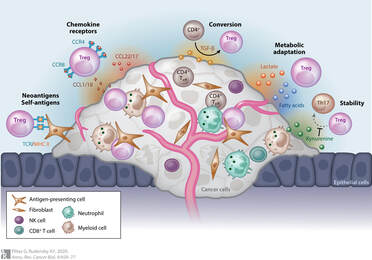Chemokines and Cancer
|
Introduction
Cancer remains one of the most formidable challenges in modern medicine, and understanding the intricate relationship between the immune system and cancer cells is crucial for developing effective treatments. One intriguing aspect of this complex interplay is the role of chemokines, small proteins that act as messengers in immune responses. In this blog, we delve into the world of chemokines and their significant impact on cancer progression and therapy. The Chemokine Connection Chemokines are signaling proteins that play a pivotal role in immune cell trafficking and communication. They act like homing beacons, guiding immune cells to specific sites within the body, such as infection sites or areas of inflammation. In the context of cancer, chemokines are central players in a multifaceted process that involves both the immune system and the tumor microenvironment. |
The Tumor Microenvironment
Within the tumor microenvironment, chemokines are secreted by cancer cells, as well as various stromal and immune cells. These chemokines create a dynamic landscape, influencing the recruitment and behavior of immune cells within and around the tumor. This interaction can have both pro- and anti-tumor effects, depending on the specific chemokines involved.
Pro-Tumor Effects of Chemokines
In some cases, chemokines can promote cancer progression by recruiting immune cells that suppress the anti-tumor immune response. For example, certain chemokines can attract regulatory T cells (Tregs) and myeloid-derived suppressor cells (MDSCs). These cells can dampen the immune system's ability to recognize and attack cancer cells, allowing tumors to grow unchecked.
Anti-Tumor Effects of Chemokines
Conversely, some chemokines play a critical role in recruiting cytotoxic immune cells, such as CD8+ T cells and natural killer (NK) cells, to the tumor site. These immune cells are essential for recognizing and destroying cancer cells. Additionally, chemokines can promote the formation of lymphoid structures within tumors, known as tertiary lymphoid structures (TLS), which serve as hubs for immune cell activation and tumor surveillance.
Targeting Chemokines in Cancer Therapy
Understanding the role of chemokines in cancer has opened up exciting possibilities for cancer therapy. Researchers are exploring various strategies to manipulate chemokine signaling to enhance anti-tumor immune responses and inhibit pro-tumor processes.
Conclusion
Chemokines, once mere bystanders in the complex landscape of immune responses, have emerged as key players in cancer progression and therapy. Their role in shaping the immune microenvironment of tumors is a growing area of research and holds great promise for developing more effective cancer treatments. As our understanding of the intricate dance between chemokines and cancer deepens, we move one step closer to harnessing the full potential of the immune system to combat this formidable disease.
Within the tumor microenvironment, chemokines are secreted by cancer cells, as well as various stromal and immune cells. These chemokines create a dynamic landscape, influencing the recruitment and behavior of immune cells within and around the tumor. This interaction can have both pro- and anti-tumor effects, depending on the specific chemokines involved.
Pro-Tumor Effects of Chemokines
In some cases, chemokines can promote cancer progression by recruiting immune cells that suppress the anti-tumor immune response. For example, certain chemokines can attract regulatory T cells (Tregs) and myeloid-derived suppressor cells (MDSCs). These cells can dampen the immune system's ability to recognize and attack cancer cells, allowing tumors to grow unchecked.
Anti-Tumor Effects of Chemokines
Conversely, some chemokines play a critical role in recruiting cytotoxic immune cells, such as CD8+ T cells and natural killer (NK) cells, to the tumor site. These immune cells are essential for recognizing and destroying cancer cells. Additionally, chemokines can promote the formation of lymphoid structures within tumors, known as tertiary lymphoid structures (TLS), which serve as hubs for immune cell activation and tumor surveillance.
Targeting Chemokines in Cancer Therapy
Understanding the role of chemokines in cancer has opened up exciting possibilities for cancer therapy. Researchers are exploring various strategies to manipulate chemokine signaling to enhance anti-tumor immune responses and inhibit pro-tumor processes.
- Blocking Pro-Tumor Chemokines: Some therapies aim to block the chemokines that attract immune-suppressing cells to the tumor, effectively removing the tumor's protective shield.
- Enhancing Anti-Tumor Chemokines: Conversely, researchers are working on strategies to boost the production of chemokines that attract cytotoxic immune cells, promoting a stronger immune response against cancer.
- Combination Therapies: Combining immunotherapies that target chemokines with other treatments like checkpoint inhibitors is a promising approach to improve cancer therapy's overall efficacy.
Conclusion
Chemokines, once mere bystanders in the complex landscape of immune responses, have emerged as key players in cancer progression and therapy. Their role in shaping the immune microenvironment of tumors is a growing area of research and holds great promise for developing more effective cancer treatments. As our understanding of the intricate dance between chemokines and cancer deepens, we move one step closer to harnessing the full potential of the immune system to combat this formidable disease.


